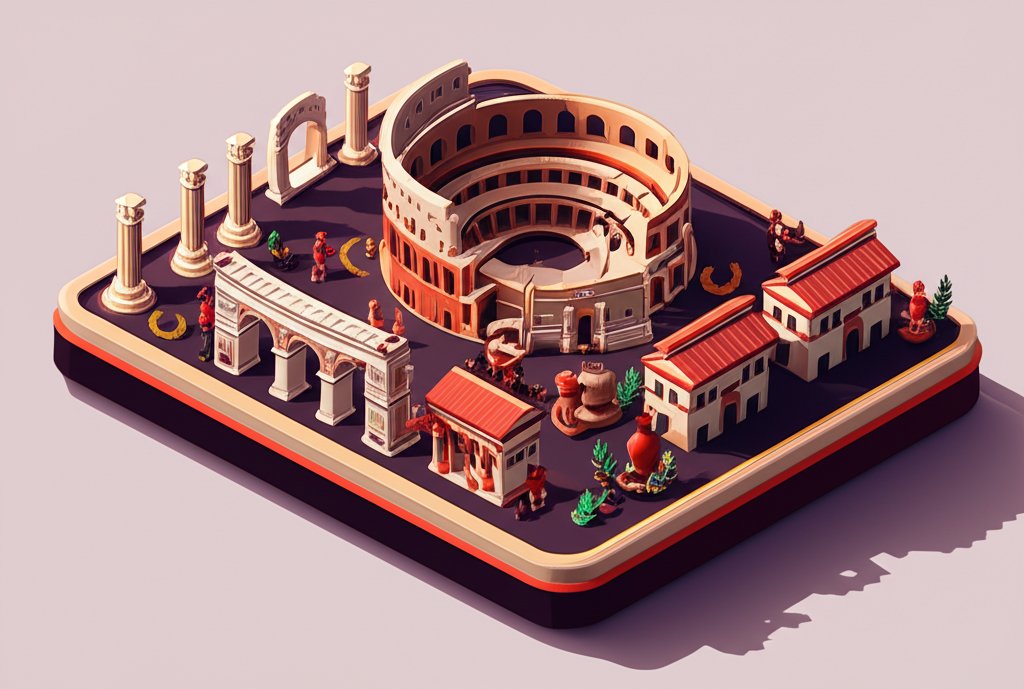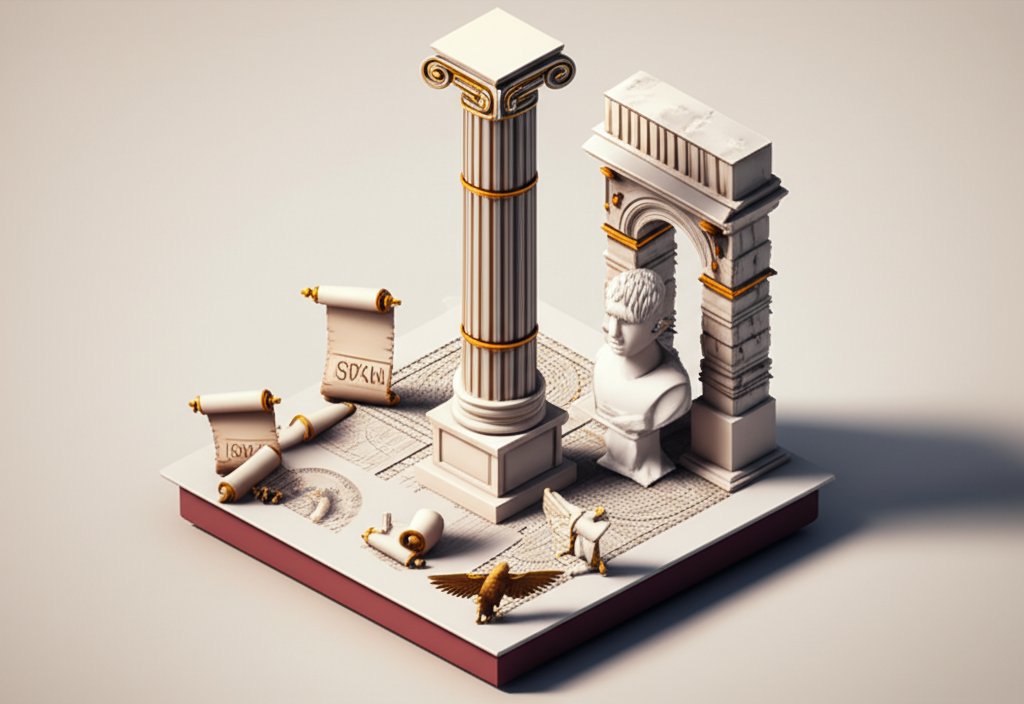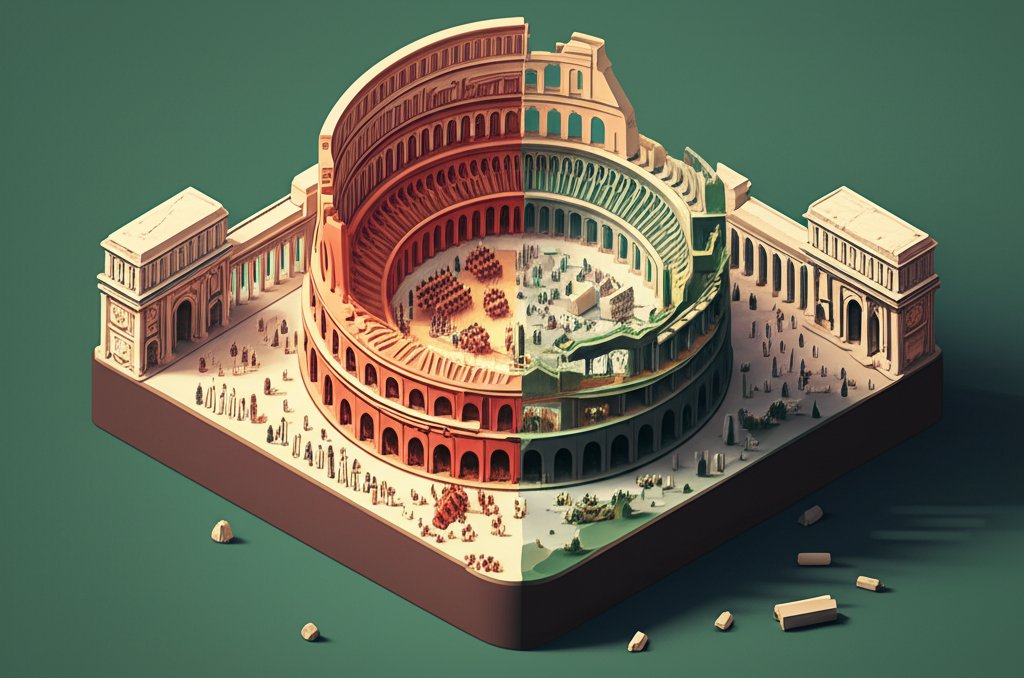Imagine a civilization that began as a humble village, grew into a republic that conquered the Mediterranean, and then transformed into an empire whose influence stretched across continents, shaping laws, languages, and cultures for millennia. This is the incredible ancient Rome history, a saga of ambition, innovation, and ultimately, decline. From its legendary origins on the banks of the Tiber to the dramatic rise and fall of Rome, its story (sejarah romawi kuno in Indonesian historiography) is a cornerstone of Western civilization, offering profound insights into human nature and the cycles of power.
This comprehensive guide will take you on an exhaustive journey through the epochs of the Roman Empire, revealing the political machinations, military triumphs, societal structures, and cultural achievements that defined one of the most influential civilizations the world has ever known. Prepare to uncover the secrets of its enduring legacy and the complex reasons behind its eventual demise.
To better understand the context of Rome’s rise from a small settlement to a dominant power, exploring an ancient history timeline can provide valuable perspective.
The Dawn of a Legend: Rome’s Humble Beginnings (753-509 BCE)
Long before it became a mighty empire, Rome was a collection of settlements nestled on seven hills overlooking the Tiber River. Its strategic location, offering both defensible positions and access to trade routes by water, was crucial to its early development.
Myth and Foundation: Romulus & Remus
The most famous origin story of ancient Rome centers around the twin brothers Romulus and Remus. According to legend, these demigods, abandoned as infants, were suckled by a she-wolf and later founded the city in 753 BCE. A dispute over leadership led Romulus to kill Remus, becoming Rome’s first king and namesake. While mythical, this tale ingrained a fierce, often brutal, determination into the Roman psyche.
The Regal Period: Early Kings and Etruscan Influence
Following Romulus, ancient Rome was ruled by a succession of seven kings (the Regal Period), a mix of Latin, Sabine, and Etruscan origins. These early monarchs established many of Rome’s foundational institutions, including the Senate, the Comitia Curiata, and the early legal framework. The later kings, particularly those of Etruscan descent like Tarquinius Superbus, brought significant advancements in engineering, architecture (the Cloaca Maxima, the Circus Maximus), and urban planning, transforming Rome into a burgeoning city-state. This period saw the fledgling city develop its military, social hierarchy, and religious practices, setting the stage for its future greatness.
The Roman Republic: Ascendancy Through Innovation (509-27 BCE)
The monarchy ended dramatically in 509 BCE with the expulsion of Tarquinius Superbus, marking the birth of the Roman Republic. This new form of government, while initially dominated by the aristocratic patricians, gradually evolved to incorporate the plebeian commoners, showcasing Rome’s remarkable capacity for political adaptation.
Birth of the Republic: Power to the People (Eventually)
At its core, the Republic was a system designed to prevent the concentration of power in one individual’s hands. It was governed by two annually elected Consuls, advised by the Senate (an assembly of elder statesmen), and supported by various assemblies and magistrates. The early Republic was characterized by the “Conflict of the Orders,” a centuries-long struggle between the patrician elite and the plebeian masses for political and social equality. Through plebeian revolts and reforms like the Twelve Tables (Rome’s first codified laws) and the creation of Tribunes of the Plebs, the Republic slowly became more inclusive, laying the groundwork for many principles of modern democracy.
Military Might and Expansion: The Punic Wars & Mediterranean Dominance
The ancient rome history of the Republic is largely defined by its relentless expansion. Through a series of bloody conflicts, most notably the three Punic Wars against its formidable rival, Carthage, Rome solidified its control over the Italian peninsula and then extended its hegemony across the Mediterranean. These wars, particularly the Second Punic War featuring Hannibal’s audacious campaigns, tested Rome’s resilience to its limits but ultimately forged an unrivaled military and naval power. By the 2nd century BCE, Rome had become the undisputed master of the Mediterranean, acquiring vast territories in Spain, North Africa, Greece, and Asia Minor. This era truly marked the initial rise of Rome as a global power.
Internal Strife and Shifting Power: Gracchi Brothers, Marius, Sulla
The Republic’s rapid expansion brought immense wealth and power, but also internal instability. The influx of slaves, the growing gap between rich and poor, and the challenges of governing a vast empire led to social unrest and political violence. Figures like the Gracchi brothers attempted land reforms but were met with assassination. Generals like Gaius Marius revolutionized the Roman army, making soldiers loyal to their commanders rather than the state, while Lucius Cornelius Sulla seized power through civil war and became dictator. These events highlighted the Republic’s inherent weaknesses and the growing influence of powerful individuals over traditional institutions.
The Age of Giants: Julius Caesar and the End of an Era
The final century of the Republic witnessed the rise of titanic figures whose ambitions would irrevocably transform Rome. Gnaeus Pompey, Marcus Licinius Crassus, and most famously, Gaius Julius Caesar, formed alliances and vied for ultimate power. Caesar, a brilliant general and charismatic politician, conquered Gaul, accumulating immense wealth and a devoted army. His crossing of the Rubicon in 49 BCE triggered a civil war that he ultimately won, leading to his appointment as dictator for life. His assassination in 44 BCE, however, plunged Rome back into chaos, setting the stage for his adopted son, Octavian, to emerge as the sole ruler and usher in a new era for the Roman Empire.
The Roman Empire: Golden Age and Unprecedented Power (27 BCE – 476 CE)

The year 27 BCE is often cited as the official beginning of the Roman Empire, with Octavian consolidating power and adopting the title Augustus. This period, lasting for several centuries, saw Rome reach its architectural, military, and cultural zenith, creating a legacy that continues to resonate.
Augustus and the Pax Romana: A New Era of Stability
Augustus skillfully transformed the Republic into an imperial system while maintaining a veneer of republican tradition. His reign brought an unprecedented period of peace and stability known as the Pax Romana (Roman Peace), lasting for over two centuries. During this time, the empire flourished, trade routes were secure, and infrastructure projects like roads, aqueducts, and public buildings proliferated. This era represents the peak of the rise of Rome, truly solidifying its image as an indomitable force.
Expansion and Administration: Governing a Vast Realm
Under Augustus and his successors, the Roman Empire reached its greatest territorial extent, encompassing colossal swathes of Europe, North Africa, and the Middle East. From Hadrian’s Wall in Britain to the deserts of Mesopotamia, Rome governed a diverse population numbering tens of millions. This required a sophisticated administrative apparatus, including a vast bureaucracy, a refined legal system, and an organized provincial governance structure, all supported by a formidable military machine. The efficiency of this administration is a testament to the ingenuity of ancient Rome history.
Daily Life and Cultural Achievements: Art, Architecture, Engineering, Law
The ancient rome period of the Empire was a hotbed of cultural and intellectual activity. Roman engineers constructed marvels like the Colosseum, the Pantheon, and extensive networks of roads and aqueducts, many of which still stand today. Roman law, with its principles of justice, property rights, and contracts, formed the basis for legal systems across Europe and beyond. Latin, the language of Rome, evolved into the Romance languages and heavily influenced English. Roman art, literature, and philosophy, while often inspired by Greek predecessors, developed distinct Roman characteristics, emphasizing practicality, grandeur, and civic virtue. These achievements remain central to understanding ancient rome history.
The Five Good Emperors and the Empire’s Zenith
Following the tumultuous reigns of emperors like Nero and Domitian, the Roman Empire experienced a period of remarkable stability and prosperity under the “Five Good Emperors” (Nerva, Trajan, Hadrian, Antoninus Pius, and Marcus Aurelius) from 96 to 180 CE. These emperors, known for their administrative competence and statesmanship, oversaw a period of peace, economic growth, and cultural flourishing, often considered the golden age of the roman empire.
The Seeds of Decline: Challenges to the Roman Empire
Despite its immense power, the Roman Empire was not immutable. From the late 2nd century CE onwards, internal weaknesses and external pressures began to erode its foundations, marking the gradual shift from the rise of Rome to its eventual decline.
Internal Pressures: Political Instability, Economic Woes, Social Divide
A cascade of internal issues plagued the empire. Political instability became rampant, with a rapid succession of emperors, many of whom were assassinated by their own legions. The “Crisis of the Third Century” (235-284 CE) saw at least 26 legitimate emperors and countless usurpers. This constant turmoil decimated the economy, as resources were diverted to endless civil wars and debasement of currency led to rampant inflation. Social inequality persisted, and a declining birth rate among the Roman elite, coupled with the reliance on foreign soldiers, weakened the traditional Roman identity and civic responsibility. Understanding these factors is crucial to grasping the rise and fall of Rome.
External Threats: Border Wars and Barbarian Invasions
While the roman empire was grappling with internal chaos, its borders faced increasing pressure from migrating “barbarian” tribes – Goths, Vandals, Huns, and others – often displaced by other powers or seeking better lands within Roman territory. Rome’s overstretched legions, depleted by civil wars and disease, struggled to defend vast frontiers against increasingly sophisticated and organized incursions. Heavy military expenditures further strained the ailing economy.
The Division of the Empire: East and West
Recognizing the immense administrative challenge of governing such a vast realm, Emperor Diocletian (r. 284-305 CE) divided the empire into Eastern and Western halves, each with its own emperor (a system known as the Tetrarchy). While initially intended to strengthen governance, this division eventually led to divergent paths. The wealthier, more urbanized Eastern Roman Empire (Byzantium) proved more resilient, while the Western half, with its less stable economy and more exposed borders, faced greater existential threats.
The Crisis of the Third Century and Diocletian’s Reforms
The Crisis of the Third Century was a period of near-collapse, characterized by civil war, economic depression, and external invasions. Diocletian’s radical reforms, including the Tetrarchy, price controls, and military reorganization, managed to stabilize the empire temporarily. Later, Emperor Constantine I (r. 306-337 CE) further solidified the division by establishing a new capital, Constantinople, in the East and by legalizing Christianity, fundamentally altering the empire’s religious landscape.
The Dramatic Fall of the Western Roman Empire (Post-395 CE)
The traditional date for the fall of the Western Roman Empire is 476 CE, when the last Western Roman Emperor, Romulus Augustulus, was deposed by the Germanic chieftain Odoacer. However, this was merely the culmination of a protracted process, a final act in the long rise and fall of Rome.
The Final Blows: Sacks of Rome and the Last Emperors
By the 5th century CE, the Western Empire was a shadow of its former self. Its core territories were frequently invaded, and the city of Rome, once inviolable, was sacked by the Visigoths in 410 CE and again by the Vandals in 455 CE. These events, though not leading to the immediate collapse of the entire empire, were deeply symbolic and psychologically devastating. Successive emperors in the West often held little real power, ruling over dwindling territories and relying on barbarian generals for protection. The end came quietly in 476 CE, marking the formal end of ancient Rome history as a unified Western political entity.
Multifaceted Collapse: Beyond a Single Date
It’s critical to understand that the fall of the Western Roman Empire wasn’t a singular event but a complex process driven by a convergence of factors:
- Economic Collapse: Hyperinflation, reduced trade, heavy taxation, and a shrinking population led to widespread impoverishment.
- Military Overstretch: The vast borders were impossible to defend with dwindling resources and a reliance on often disloyal foreign mercenaries.
- Political Corruption and Instability: Weak emperors, constant usurpations, and a fragmented administrative system paralyzed effective governance.
- Social Decay: A widening gap between rich and poor, declining civic participation, and the erosion of traditional Roman values contributed to a loss of collective purpose.
- Barbarian Migrations: Persistent and overwhelming pressure from Germanic tribes, often seeking refuge from the Huns, eventually overran Roman defenses.
What Truly Led to the Rise and Fall of Rome?
Historians still debate the primary causes of Rome’s collapse. Was it the sheer size of the Roman Empire, making it ungovernable? Was it Christianity undermining traditional values, as some suggest? Or was it an inevitable demographic and economic decline exacerbated by climate change or repeated plagues? Most scholars agree it was a confluence of these interconnected internal and external factors that ultimately brought about the dramatic fall of Rome. The story of sejarah romawi kuno teaches us that even the mightiest civilizations are vulnerable to cycles of growth and decline, often from within.
The Enduring Legacy of Ancient Rome History
Even after its political collapse, ancient Rome history left an indelible mark on the world. Its innovations and achievements became the bedrock upon which much of Western civilization was built, truly embodying the phrase sejarah romawi kuno as a foundational history.
Law and Governance: Foundations of Modern Systems
Roman law, particularly the Justinian Code compiled in the Eastern Roman Empire, influenced legal systems globally. Concepts like civil rights, contracts, property law, and the principle of “innocent until proven guilty” trace their origins back to Roman jurisprudence. The very idea of a republic, with its elected representatives and separation of powers, draws heavily from the Roman model.
Language and Literature: Latin’s Lingering Echo
Latin, the language of Rome, is the direct ancestor of modern Romance languages (Italian, French, Spanish, Portuguese, Romanian) and heavily influenced English, with over 60% of its vocabulary derived from Latin or Greek. Roman literature, including works by Virgil, Ovid, Cicero, and Seneca, continues to be studied and admired for its literary merit and insights into the human condition.
Architecture and Engineering: Timeless Marvels
The Romans were master builders and engineers. Their concrete, arches, domes, aqueducts, roads, and public baths showcase an unparalleled understanding of construction and urban planning. Structures like the Colosseum, the Pantheon, and Roman bridges still inspire awe and demonstrate a level of architectural sophistication that was not replicated for centuries. Many modern cities still benefit from the foundational planning laid down by the roman empire.
Cultural Influence and Enduring Inspiration
Beyond specific innovations, the roman empire profoundly shaped Western thought, art, and identity. Its pagan mythology, later syncretized with Christianity, shaped religious and artistic expression. Its emphasis on civic duty, military prowess, and the pursuit of glory permeated subsequent European cultures. For centuries, various European powers would attempt to emulate or revive the “Roman idea,” a testament to its enduring power as a symbol of civilization and order. The comprehensive study of ancient rome history, or sejarah romawi kuno, remains vital for understanding the roots of our modern world.
Conclusion

The ancient Rome history is a truly colossal narrative, a testament to human ingenuity, ambition, and the cyclical nature of power. From its legendary foundation to the pragmatic genius of its Republic and the unmatched might of the Roman Empire, Rome’s trajectory was one of relentless expansion and cultural efflorescence. Yet, as our journey through the rise and fall of Rome reveals, even the greatest empires are susceptible to the corrosive forces of internal division, economic strain, and external pressure.
The study of sejarah romawi kuno is not merely an academic exercise; it offers profound lessons on governance, military strategy, social cohesion, and the delicate balance required to sustain a vast and complex society. The echoes of Rome – in our laws, languages, architecture, and political thought – confirm that while its physical empire may have crumbled, its legacy continues to shape and inspire us, ensuring that the Roman Empire will forever remain a cornerstone of human civilization.
FAQ Section: Understanding Ancient Rome
Q1: When was ancient Rome founded, and by whom?
A1: According to legend, ancient Rome was founded in 753 BCE by twin brothers Romulus and Remus. Romulus is traditionally considered its first king.
Q2: What were the three main periods of ancient Rome history?
A2: The three main periods of ancient Rome history are:
Q3: What was the significance of the roman empire’s expansion?
A3: The expansion of the Roman Empire created a vast, unified economic and cultural zone across Europe, North Africa, and the Middle East. It spread Roman law, Latin language, architectural styles, and administrative practices, forming the basis for many future European nations and profoundly influencing global development. This expansion was a key element in the rise and fall of Rome as it brought both immense wealth and insurmountable challenges.
Q4: What were the key factors in the rise and fall of Rome?
A4: The rise of Rome was fueled by strong military organization, political adaptability (especially during the Republic), effective administration, and strategic geographic positioning. The fall of Rome (specifically the Western Empire) was a complex process attributed to a combination of factors including political instability, economic decline, overextension of borders, barbarian invasions, social decay, and possibly environmental changes.
Q5: How has ancient Rome history influenced modern society?
A5: Ancient Rome history has profoundly influenced modern society in numerous ways:
Q6: What is sejarah romawi kuno?
A6: Sejarah romawi kuno is the Indonesian phrase for “ancient Roman history.” It refers to the study and narrative of the civilization of ancient Rome, from its legendary founding through the periods of the Republic and Empire, up to the fall of the Western Roman Empire.










